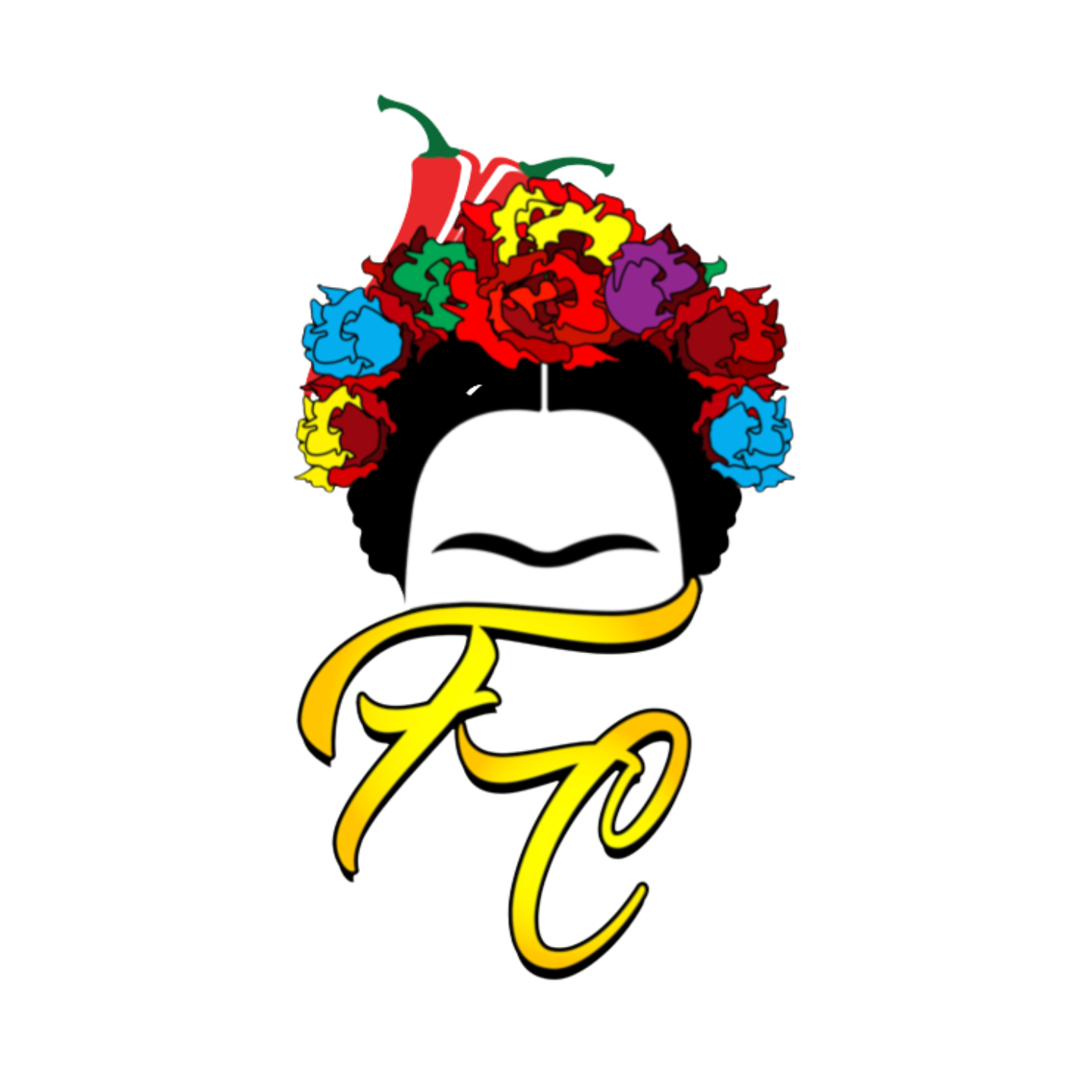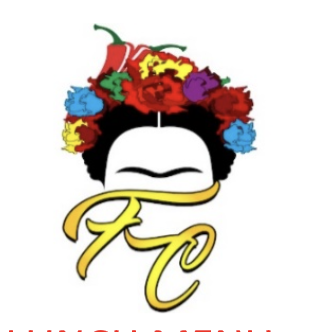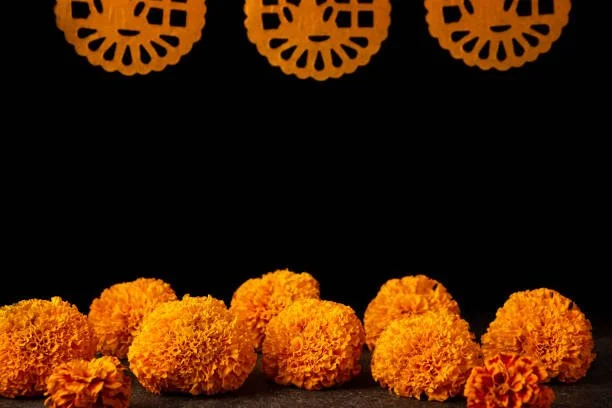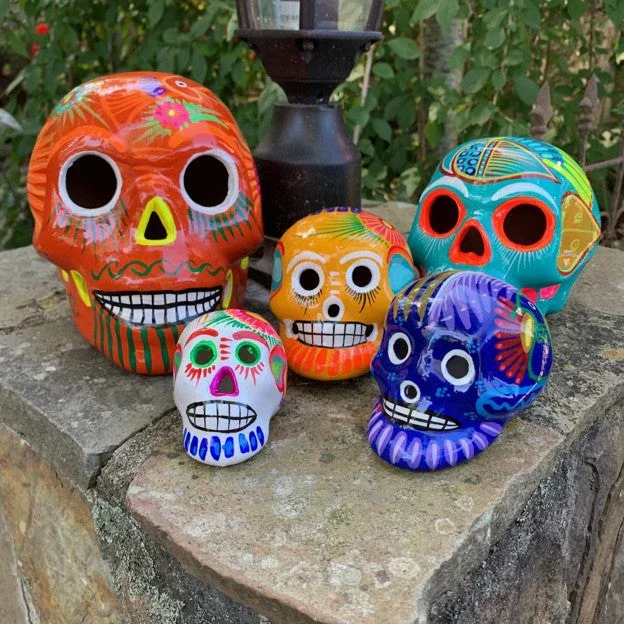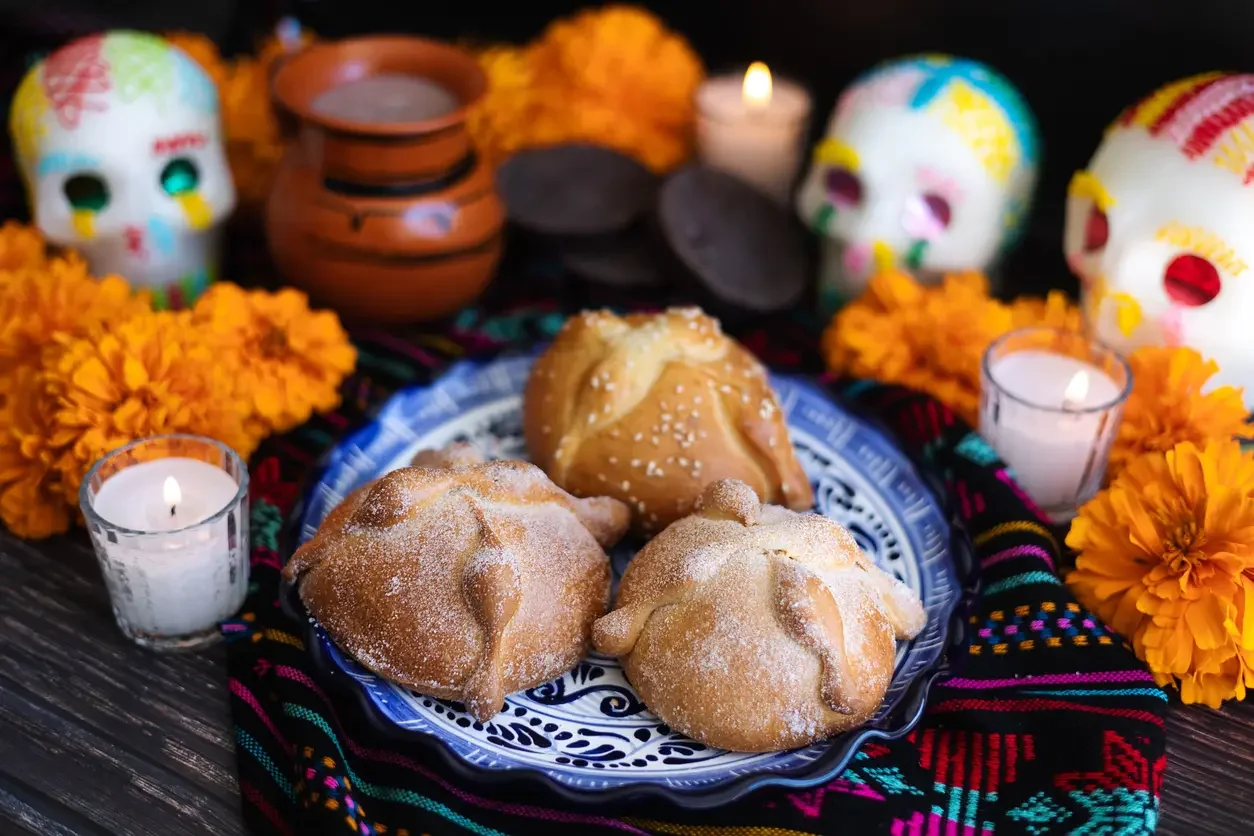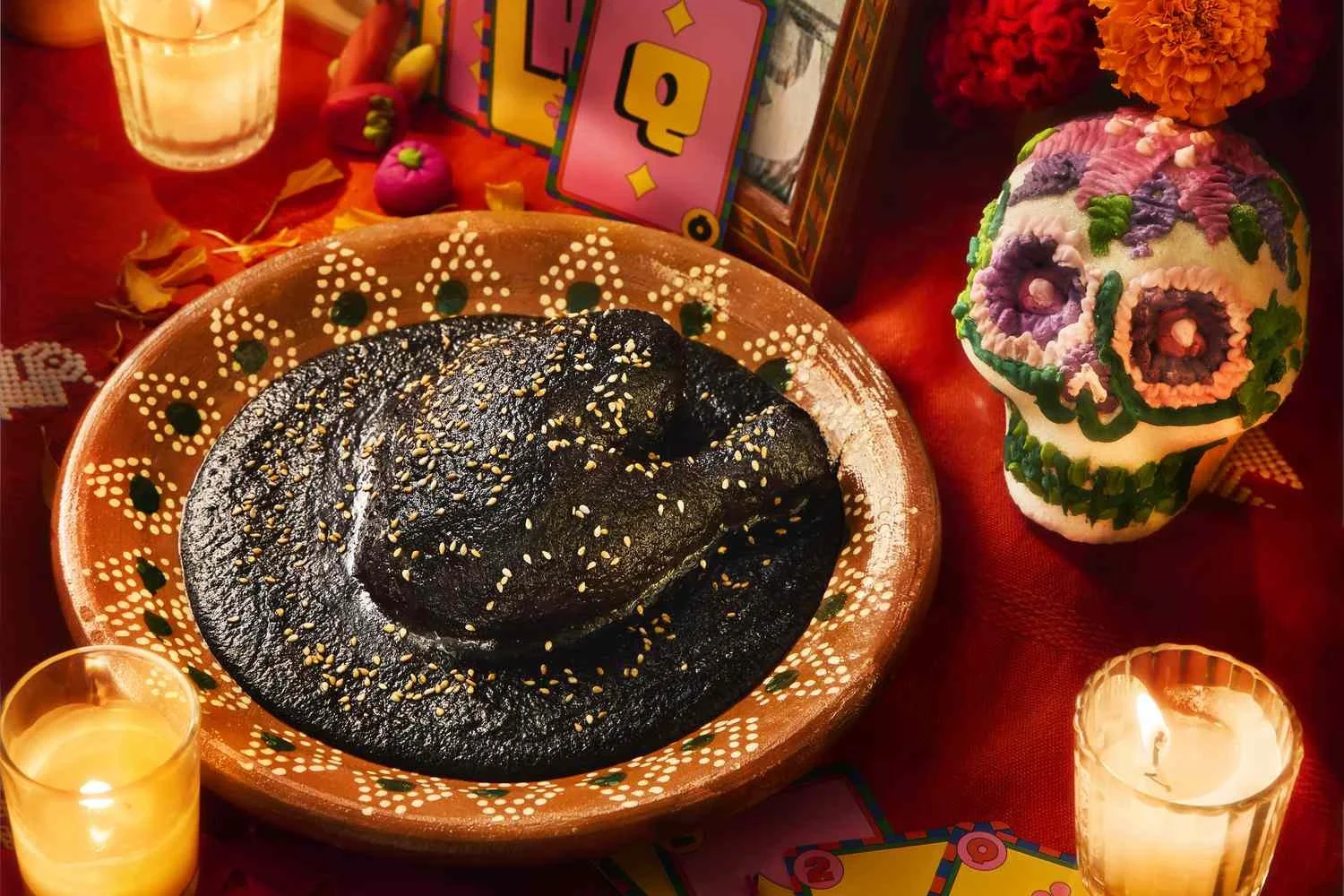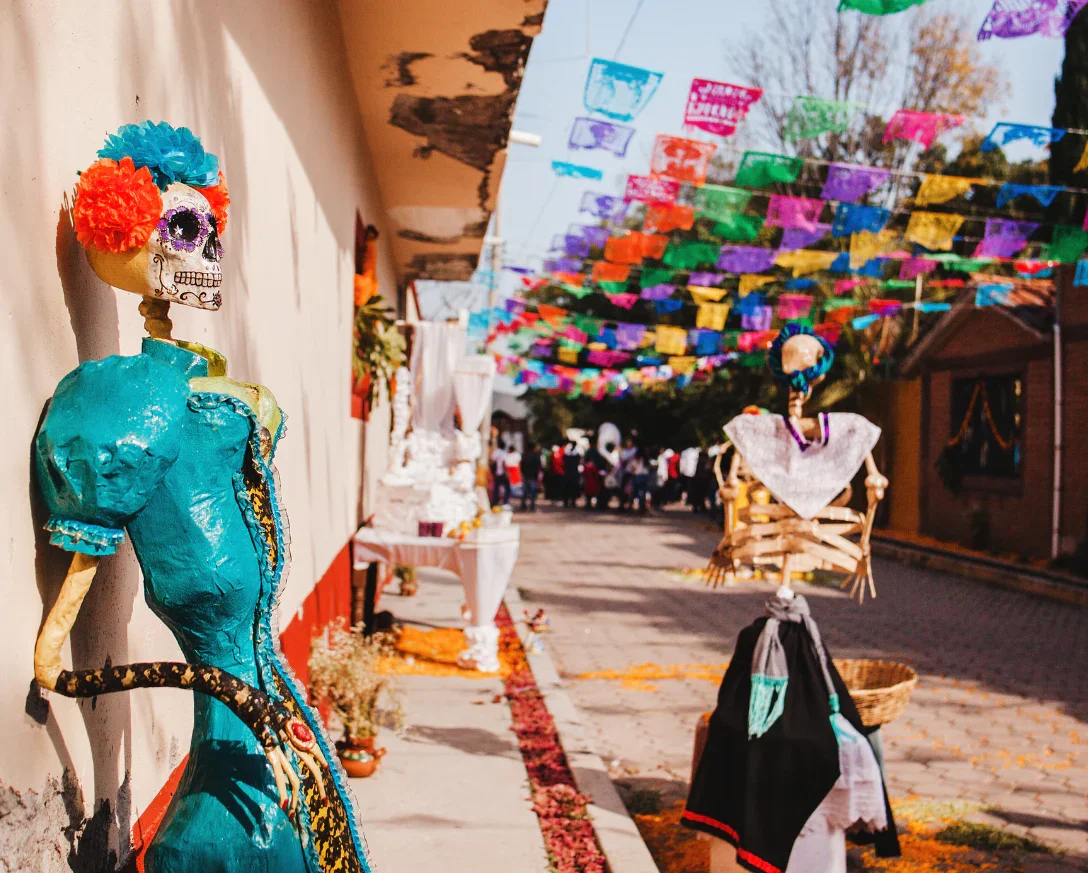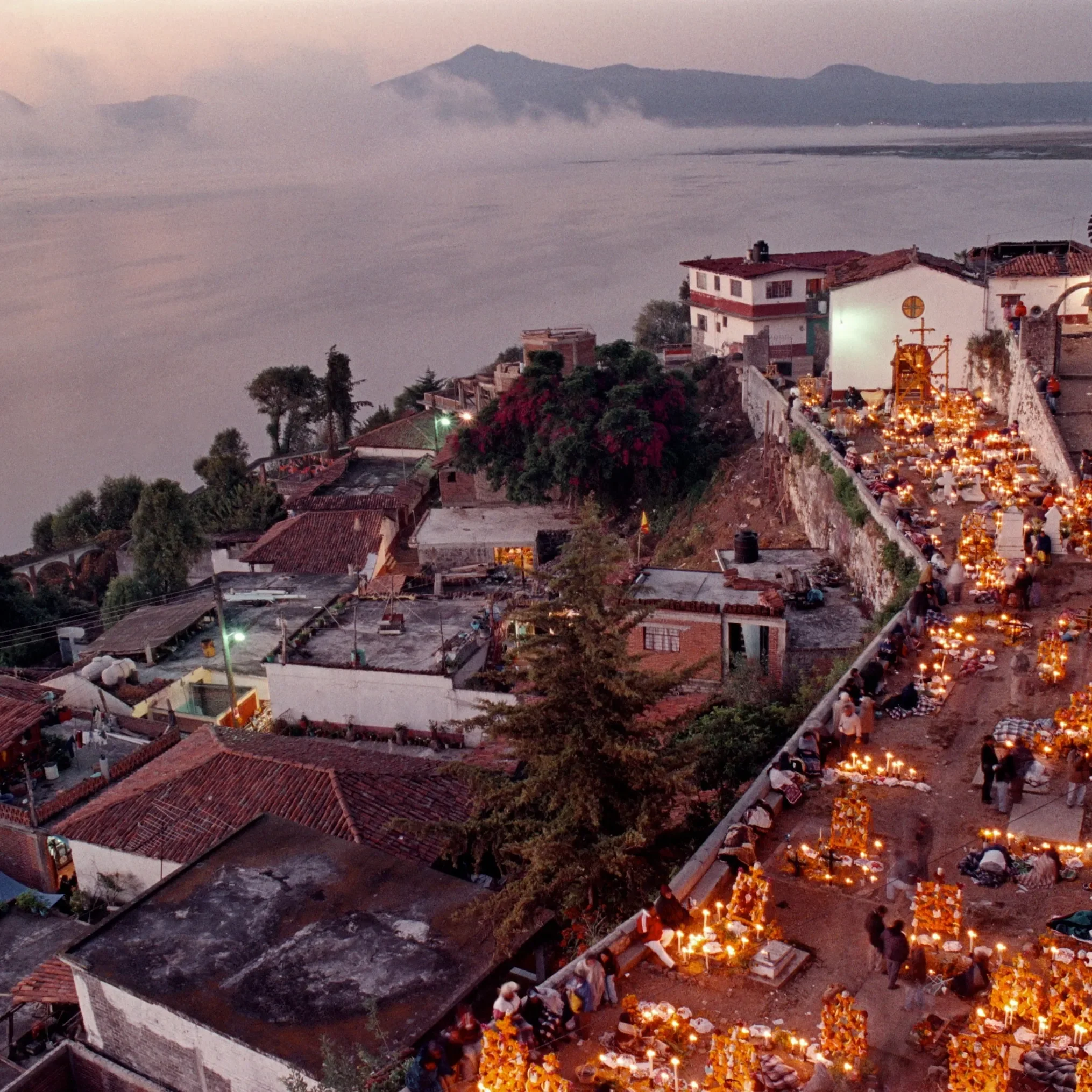Día de los Muertos: The Complete Guide to Mexico’s Day of the Dead
Colorful Mexican Day of the Dead altar decorated with pan de muerto and family photographs
At its heart, Día de los Muertos is a triumphant celebration of life through the remembrance of those who came before us. Far from the somber mourning often associated with death in other cultures, Mexico’s Day of the Dead transforms loss into celebration, grief into gratitude, and endings into eternal connections. This extraordinary holiday unites families and communities across Mexico and beyond in joyful remembrance, vibrant colors, and sacred rituals that honor both the living and the departed.
Each autumn, as the golden marigolds bloom and the sweet scent of copal incense fills the air, Mexico comes alive with one of the world’s most profound and beautiful celebrations. Día de los Muertos, observed on November 1 and 2, creates a bridge between worlds where altars overflow with pan de muerto and sugar skulls, cemeteries glow with thousands of flickering candles, and families gather to commune with the spirits of their ancestors. While Halloween tends to highlight spooky fun and playfulness, Día de los Muertos radiates warmth, love, and the unbreakable bonds that connect us across time and space.
Recognized by UNESCO as an Intangible Cultural Heritage of Humanity, Día de los Muertos represents one of humanity’s most beautiful approaches to mortality—viewing death not as an end but as a transformation, a passage that allows the departed to return annually to their loved ones. This comprehensive guide explores the deep historical roots, rich symbolism, traditional foods, regional variations, modern evolution, and practical ways to respectfully participate in this magnificent celebration of life, death, and the eternal connections that bind us all.
Historical Origins and Ancient Roots
Pre‑Columbian Foundations
Long before Spanish colonizers arrived in the Americas, the indigenous peoples of Mesoamerica had developed sophisticated understandings of death and the afterlife that would form the foundation of modern Día de los Muertos celebrations. The Aztec empire, in particular, held elaborate festivals honoring their goddess of death, Mictecacihuatl, known as “Lady of the Dead” or “Fleshless Lady.” This powerful deity presided over Mictlán, the Aztec underworld, where souls journeyed after death in a complex spiritual geography that reflected their deep understanding of life’s cyclical nature.
The original Aztec celebrations of death lasted not just days but entire months, demonstrating the central importance of ancestor veneration in pre‑Hispanic culture. During the ninth month of their calendar (roughly August), the Aztecs celebrated Miccailhuitontli, or “Little Feast of the Dead,” dedicated to deceased children. The tenth month brought Miccailhuitl, or “Great Feast of the Dead,” honoring adults who had passed on. These elaborate festivals included ritual offerings of food, flowers, pottery, and personal belongings placed on altars to nourish and welcome returning spirits.
The indigenous worldview that shaped these celebrations saw death as a natural transition rather than an ending—a perspective that would prove remarkably resilient through centuries of cultural change. Death was understood as part of an eternal cycle in which the departed continued to play active roles in their families’ lives, requiring regular attention, offerings, and communication. This cyclical understanding of existence, where life and death flowed into each other like seasons, created the philosophical foundation upon which modern Día de los Muertos would be built.
Spanish Colonial Influence and Cultural Blending
When Spanish colonizers arrived in the early 16th century, they encountered indigenous death practices that both fascinated and challenged them. Catholic missionaries, intent on converting native peoples, quickly realized that erasing these deeply rooted traditions would be nearly impossible. Instead, they took a more strategic approach—introducing Catholic beliefs and observances in ways that could coexist with existing rituals.
The Catholic calendar offered a practical overlap with indigenous ceremonies. All Saints’ Day (November 1) and All Souls’ Day (November 2), which honor saints and departed souls, closely aligned with the timing of native death festivals. This allowed missionaries to gradually shift indigenous celebrations to coincide with Christian holidays.
follow us
Over time, Catholic symbols, prayers, and rituals were layered into indigenous customs. Rather than one tradition replacing another, they became intertwined—forming the unique and meaningful celebration of Día de los Muertos that continues to evolve today.
However, scholars continue to debate the exact balance of indigenous versus European influences in modern Día de los Muertos celebrations. Some argue the holiday is primarily a Catholic import with indigenous decorative elements; others maintain pre‑Hispanic cosmology and ritual practices form its essential core, with Catholic symbols added as a protective layer. This ongoing scholarly discussion reflects the complex cultural negotiations that created one of Mexico’s most important traditions.
The colonial period also saw the development of regional variations as different indigenous groups incorporated their own local traditions and as Catholic influences varied geographically. What emerged was not a single uniform celebration but a rich tapestry of related practices that shared common elements while expressing local cultural identities. This regional diversity became one of Día de los Muertos’ defining characteristics, allowing communities across Mexico to honor their specific histories and traditions while participating in a shared national celebration.
Sacred Symbols and Their Deep Meanings
Marigolds (Cempasúchil) — The Golden Path Home
No symbol captures the essence of Día de los Muertos more powerfully than the vibrant marigold, known in Nahuatl as cempasúchil, meaning “twenty flower.” These golden‑orange blossoms serve as the “flowers of the dead,” creating luminous pathways that guide departed souls back to the world of the living. The tradition of using marigolds traces back to pre‑Hispanic times when indigenous peoples bred these flowers specifically for religious and ceremonial purposes.
The marigolds’ distinctive characteristics make them perfect spiritual guides. Their intense, almost overwhelming fragrance can be detected from great distances, serving as an olfactory beacon for returning spirits. The bright golden‑orange color represents the sun and fire—elements associated with life force and spiritual energy in indigenous cosmology. During Día de los Muertos, families scatter marigold petals in elaborate patterns, creating winding trails from cemetery gates to family plots, and from front doors to home altars.
The process of creating these floral pathways becomes a meditative family ritual. Children and adults work together, carefully dropping petals to form unbroken lines that spirits can follow home. Some families create intricate designs and mandala‑like patterns around graves and altars, transforming sacred spaces into gardens of remembrance. The visual impact is stunning—thousands of bright petals creating golden rivers that flow through cemeteries and neighborhoods, connecting the worlds of the living and the dead.
Beyond their practical spiritual function, marigolds represent the indigenous understanding of death as transformation rather than termination. Just as the flowers bloom brilliantly before withering, human life reaches full flowering before transitioning to another form of existence. The flowers’ annual cycle—dying back in winter and returning each autumn—mirrors the belief that departed souls follow similar patterns of absence and return.
Sugar Skulls (Calaveras) — Sweet Reminders of Mortality
The cheerful sugar skulls that grace Día de los Muertos altars and markets represent one of the holiday’s most distinctive and philosophically rich symbols. These calaveras, crafted from pressed sugar or molded clay, transform death’s traditional image from fearsome specter to colorful celebration. Far from macabre, these skulls embody the Mexican approach to mortality—direct, honest, and ultimately joyful.
Traditional sugar skulls are works of art requiring considerable skill and patience to create. Artisans press granulated sugar mixed with water and meringue powder into skull‑shaped molds, then carefully remove and decorate them with bright icing in intricate patterns. Typical decorations include swirling designs, flower motifs, geometric patterns, and most importantly, the name of a specific deceased person written across the forehead. This personalization transforms each skull from a generic symbol into a specific memorial.
Colorful sugar skulls.
The symbolism embedded in sugar skulls operates on multiple levels. The sugar itself represents life’s sweetness and the pleasure that should be remembered even in death. The skull’s direct imagery confronts mortality without fear or denial, embodying the Mexican cultural value of facing death honestly rather than avoiding its reality. By decorating skulls with bright colors, flowers, and playful designs, families strip death of its terror and transform it into something beautiful and celebratory.
The practice of eating sugar skulls adds another dimension to their symbolism. By literally consuming death’s image, participants symbolically incorporate mortality into life, acknowledging death as an integral part of existence rather than its opposite. Children especially enjoy this aspect, learning to associate death with sweetness rather than fear, creating healthier psychological relationships with mortality from an early age.
La Catrina — The Elegant Face of Death
Perhaps no single figure better represents the spirit of Día de los Muertos than La Catrina, the elegantly dressed skeleton who has become the holiday’s most recognizable icon. Her story begins in 1910 with Mexican artist José Guadalupe Posada, who created an etching called “La Calavera Garbancera”—a well‑dressed skeleton meant to satirize Mexico’s class‑conscious society. Posada’s original figure wore a fancy hat and elegant clothing, mocking those who adopted European fashions and denied their indigenous heritage.
The transformation of Posada’s satirical skeleton into beloved cultural icon occurred through the work of muralist Diego Rivera, who featured her prominently in his 1947 mural “Dream of a Sunday Afternoon in Alameda Park.” Rivera renamed her “Catrina” (meaning “elegant” or “well‑dressed”) and placed her at the center of Mexican cultural identity, surrounded by historical figures representing the nation’s complex heritage. Through Rivera’s artistic vision, La Catrina evolved from social commentary to cultural symbol.
Dream of a Sunday Afternoon in Alameda Park by Diego Rivera
Modern Día de los Muertos celebrations have embraced La Catrina as the holiday’s unofficial ambassador. Her image appears on altar decorations, festival posters, and in elaborate makeup and costume traditions. The intricate face painting required to become Catrina—white base with black accents highlighting bone structure and decorated with colorful flowers and swirling designs—has become an art form in itself.
La Catrina’s enduring appeal stems from her embodiment of Día de los Muertos’ central message: death comes to everyone regardless of social status, wealth, or pretension. Her elegant appearance demonstrates that death need not be feared or hidden but can be acknowledged with dignity and even style. In contemporary celebrations, participants don Catrina makeup and costumes not to frighten but to celebrate, transforming themselves into beautiful representations of mortality accepted and embraced.
Other Essential Symbolic Elements
The rich symbolic vocabulary of Día de los Muertos extends far beyond marigolds, skulls, and Catrina to include numerous other elements, each carrying specific meanings and functions in the celebration. Papel picado, the delicate tissue paper banners cut into intricate designs, represents the fragility of life and the beauty found in temporary existence. As these colorful papers flutter in cemetery breezes and around home altars, they symbolize the movement between worlds and the ephemeral nature of all existence.
Candles and their flames serve multiple symbolic functions. Each flickering flame represents a soul and lights the pathway spirits must follow to reach the world of the living. The warmth of candlelight creates welcoming spaces for returning ancestors, while the light itself symbolizes hope, faith, and the continuation of love beyond death. Families often light specific numbers of candles corresponding to departed family members, creating a personal constellation of remembrance.
Copal incense, burned in clay braziers, carries prayers and offerings to the spiritual realm while purifying sacred spaces. This aromatic tree resin was sacred to pre‑Hispanic cultures and continues to play a central role in indigenous and mestizo spiritual practices. The rising smoke creates a visual connection between earth and heaven, while its distinctive fragrance marks spaces as sacred and conducive to spiritual communication.
The four elements—earth, air, fire, and water—are deliberately incorporated into most altars and celebrations, representing the universal forces that govern both life and death. Earth appears as salt for purification and sustenance, air as incense smoke and fluttering papel picado, fire as candles and their flames, and water as drinks offered to thirsty spirits. This elemental inclusion reflects indigenous cosmological understanding of death as part of natural cycles rather than supernatural events.
The Sacred Ofrenda — Building Bridges Between Worlds
Structure and Sacred Architecture
The ofrenda, or altar, serves as the sacred centerpiece of Día de los Muertos celebrations, functioning as both memorial and meeting place where living and dead can commune. These carefully constructed spaces represent one of humanity’s most beautiful expressions of love transcending death, combining artistic creativity with spiritual devotion to create bridges between worlds.
Traditional ofrendas follow specific architectural principles that reflect indigenous and Catholic cosmological understanding. Two‑level altars represent earth and heaven, acknowledging the basic spiritual division between physical and transcendent realms. Three‑level structures add purgatory, incorporating Catholic theology about souls’ intermediate state. The most elaborate seven‑level altars represent the stages souls must pass through to reach spiritual rest, with each level containing specific types of offerings appropriate to that spiritual stage.
La Ofrenda en Dia de los Muertos
The physical construction of ofrendas becomes a family ritual that begins weeks before November 1. Families gather materials—tables, boxes, boards, and cloth—to create stepped platforms covered with beautiful textiles, often including traditional Mexican fabrics, family heirlooms, and specially purchased altar cloths. The arrangement process involves careful consideration of each element’s placement, with photographs positioned prominently and offerings arranged in aesthetically pleasing and spiritually meaningful patterns.
Color coordination plays a crucial role in ofrenda design, with specific hues carrying symbolic meanings. Purple represents mourning and the Catholic liturgical color for souls in purgatory. Yellow and orange echo marigold colors and symbolize death in indigenous traditions. Pink represents celebration and joy in death. White signifies purity, hope, and the innocence of children. Black acknowledges the reality of death without fear. Red symbolizes life force and the blood that connects families across generations.
Essential Components and Their Sacred Functions
Every authentic ofrenda incorporates specific elements, each serving distinct spiritual and cultural functions in welcoming departed souls home. Photographs of the deceased form the altar’s emotional and spiritual center, usually placed at the highest level to honor the departed and help visitors focus their prayers and memories. These images often include multiple generations, creating visual family trees that celebrate continuing connections across time.
Personal belongings and mementos transform ofrendas from generic memorials into intimate spaces reflecting individual personalities and relationships. Favorite clothing items, jewelry, books, musical instruments, tools, toys, or other significant objects help returning spirits recognize their special places and feel welcomed home. These personal touches often become conversation starters, allowing family members to share stories with visitors, especially children learning family history.
Religious and spiritual items reflect the blending of traditions that shape Día de los Muertos, often including Catholic images, crosses, prayer cards, and rosaries placed alongside indigenous symbols and artifacts. Some families include pre‑Hispanic deity figures, crystals, or other spiritual objects reflecting their particular beliefs and heritage. This spiritual diversity demonstrates Día de los Muertos’ remarkable capacity to embrace multiple faith traditions while maintaining its essential character.
Food and beverage offerings represent perhaps the most important ofrenda elements, as they provide nourishment for spirits undertaking long journeys from the realm of the dead. Traditional offerings always include the deceased person’s favorite foods and drinks, prepared exactly as they enjoyed them in life. Common items include fresh fruit (especially oranges and apples), bread, chocolate, coffee, and elaborate dishes prepared specifically for the occasion.
Water serves multiple functions, offered in beautiful glasses or traditional clay vessels to quench spirits’ thirst. Salt, representing purification and preservation, helps cleanse returning souls and protect sacred spaces from negative influences. Some families include soap, towels, and mirrors, providing facilities for spirits to refresh themselves before rejoining family celebrations.
Traditional Foods — Nourishing Body and Soul
Pan de Muerto — The Sacred Bread of Remembrance
Pan de muerto stands as perhaps the most iconic and universally recognized food of Día de los Muertos, a sweet bread whose very form embodies the holiday’s central themes of life, death, and resurrection. This circular loaf, adorned with bone‑shaped dough strips arranged in cross patterns and topped with a central knob representing a skull, transforms the basic act of bread‑making into profound spiritual symbolism.
Pan de Muerto - Dia de los Muertos
The bread’s preparation begins weeks before November 1 in bakeries across Mexico and Mexican communities worldwide. Traditional recipes call for a rich, sweet dough enhanced with eggs, butter, and sugar, then flavored with distinctive ingredients that vary by region. Orange zest and anise seeds provide the most common flavoring, creating a subtle citrus‑and‑licorice taste that distinguishes pan de muerto from ordinary sweet bread. Some regions prefer vanilla, cinnamon, or even orange blossom water; others incorporate sesame seeds or brush finished loaves with orange‑scented syrup.
The symbolic significance embedded in pan de muerto’s design reflects both Christian and indigenous spiritual concepts. The circular shape represents the cycle of life and death, with no beginning or end, while the bone‑shaped decorations acknowledge mortality without fear. The cross pattern formed by the bone strips references Catholic symbolism of resurrection and eternal life. When families break and share pan de muerto, they participate in a communion that includes both living and dead family members.
Regional variations of pan de muerto demonstrate the bread’s adaptability to local tastes and traditions. In Oaxaca, bakers create elaborate animal shapes—rabbits, birds, and human figures—alongside traditional round loaves. Michoacán’s version often includes whole anise seeds pressed into the surface, while Veracruz bakers brush their loaves with piloncillo syrup for extra sweetness. Mexico City bakeries produce countless variations, from miniature individual rolls to enormous festival loaves decorated with colored sugar.
Mole Negro — The Sacred Sauce of Celebration
Mole negro represents the pinnacle of Mexican culinary art and holds special significance during Día de los Muertos as one of the most labor‑intensive and symbolically rich foods prepared for the celebration. This complex sauce, originating in Oaxaca but now prepared throughout Mexico, requires dozens of ingredients and days of preparation, making it a true labor of love worthy of honoring departed ancestors.
The preparation of authentic mole negro begins with selecting and preparing chiles—typically including chilhuacles negros, mulatos, anchos, chipotles, and pasillas. These dried peppers must be carefully cleaned, deseeded, toasted to perfect doneness, and soaked until soft enough to blend. The nuts and seeds—almonds, peanuts, pecans, walnuts, sesame seeds, and pumpkin seeds—require individual toasting to develop full flavor. Spices and aromatics—cinnamon, cloves, black pepper, thyme, oregano, and bay leaves—must be ground fresh.
Mole Negro - Dia de los Muertos
The sauce’s complexity extends beyond ingredients to include fruits and vegetables that add sweetness and body: tomatoes, tomatillos, onions, garlic, plantains, and sometimes pineapple or raisins. Chocolate and piloncillo provide the final touches that balance the sauce’s heat and create its distinctive flavor profile. The grinding and cooking process traditionally takes three days, with family members taking turns at the metate (grinding stone) and stirring enormous pots over wood fires.
Mole negro’s significance during Día de los Muertos extends beyond its extraordinary flavor to encompass cultural and spiritual dimensions. The sauce’s dark color symbolizes death and the earth, while its complex flavor represents life’s richness and variety. The communal preparation process strengthens family bonds and provides opportunities to share stories, techniques, and memories across generations. When served during Día de los Muertos celebrations, mole negro honors both the living cooks who prepared it and the departed family members who taught them the recipe.
Traditional Beverages and Sweet Offerings
The liquid offerings placed on Día de los Muertos altars and served during celebrations reflect both indigenous and colonial influences, creating a rich tradition of beverages that comfort the living and nourish returning spirits. Atole, a warm drink made from masa harina, water or milk, and various flavorings, represents one of Mexico’s most ancient beverages, with roots in pre‑Hispanic culture. During Día de los Muertos, families prepare champurrado, a chocolate‑flavored version of atole that combines indigenous cacao with Spanish‑introduced cinnamon and sugar.
Café de olla, coffee brewed in clay pots with cinnamon and piloncillo, provides another traditional offering that bridges indigenous and colonial traditions. The clay pot imparts an earthy flavor while the piloncillo adds complex sweetness. This coffee often appears on altars alongside cups of hot chocolate prepared with traditional Mexican techniques—whisked to create foam and flavored with vanilla, cinnamon, or chile peppers.
Alcoholic beverages also hold special places on many Día de los Muertos altars, particularly when they were favorites of the departed. Tequila, mezcal, pulque, and beer commonly appear as offerings, while some families prepare traditional fermented drinks like tepache (fermented pineapple drink) or tejuino (fermented corn beverage). These alcohol offerings acknowledge that death does not eliminate the personality traits and preferences that made each person unique.
Sweet treats beyond pan de muerto include regional specialties that reflect local ingredients and traditions. Calabaza en tacha (candied pumpkin) is a popular altar sweet, made by slow‑cooking pumpkin pieces in piloncillo syrup until tender and translucent. Dulce de camote (sweet potato candy), ate (fruit leather), and various crystallized fruits provide additional sweetness for both spirits and living celebrants.
Regional Culinary Specialties
Each region of Mexico contributes distinctive foods to Día de los Muertos celebrations, reflecting local ingredients, cooking techniques, and cultural influences. In Oaxaca, culinary offerings extend far beyond mole negro to include tasajo (salt‑cured beef), chiles rellenos de picadillo, and nicuatole (a corn‑based dessert flavored with cinnamon). The state’s seven moles each carry specific cultural significance, with different families specializing in particular varieties passed down through generations.
Michoacán’s Día de los Muertos foods reflect the state’s rich agricultural heritage and indigenous Purépecha culture. Corundas (triangular tamales wrapped in corn leaves), uchepos (sweet fresh corn tamales), and churipo (beef and vegetable soup) appear on altars alongside sweets like ate moreliano and chongos zamoranos. The region’s famous carnitas often feature in family feasts celebrating returning ancestors.
Yucatán’s Hanal Pixán celebration incorporates distinctive Mayan ingredients and cooking techniques into Día de los Muertos observances. Mucbipollo (a large tamale cooked in underground pits), pibinal (pork cooked in achiote), and sikil pak (pumpkin seed dip) reflect the peninsula’s unique culinary identity. These foods connect contemporary celebrations to ancient Mayan traditions while honoring Spanish and Lebanese influences that have shaped regional cuisine.
Regional Celebrations Across Mexico
Oaxaca — The Cultural and Artistic Heart
Oaxaca state, in southern Mexico, hosts some of the most authentic and elaborate Día de los Muertos celebrations in the country. The state capital, Oaxaca City, becomes a pilgrimage destination for visitors seeking to experience the holiday’s deepest cultural expressions, while indigenous communities throughout the state maintain practices that have remained virtually unchanged for centuries.
The celebrations in Oaxaca begin well before November 1 with elaborate market preparations: vendors sell marigolds grown nearby, intricate paper decorations, traditional foods, and crafted altar supplies. Local artisans display alebrijes—fantastical wooden creatures painted in brilliant colors—that serve as spirit guides and protective figures during the celebrations.
Dia de los Muertos Oaxaca
Cemetery celebrations in Oaxaca represent the holiday’s most moving and authentic expressions. Families arrive at gravesites carrying meals, marigold arrangements, and carpet‑like petals that transform burial grounds into gardens of remembrance. Nearby communities host all‑night vigils: families clean and decorate graves, prepare traditional foods over portable stoves, and share meals with both living relatives and departed souls. The atmosphere combines reverence with celebration as mariachi groups perform favorite songs of the deceased while children play among candlelit graves.
Artistic traditions reach a high expression in Oaxaca’s craftsman communities. San Bartolo Coyotepec produces distinctive black pottery used for altar vessels and decorations. San Martín Tilcajete and Arrazola create famous alebrijes. Santo Tomás Jalieza specializes in textiles used for altar coverings and traditional clothing. These artistic traditions ensure Día de los Muertos remains a living culture rather than merely a tourist attraction.
Michoacán — Pátzcuaro and the Island of Janitzio
Michoacán’s Día de los Muertos celebrations, centered around the colonial city of Pátzcuaro and the island of Janitzio, create some of Mexico’s most visually stunning and emotionally powerful remembrance rituals. Lake Pátzcuaro, surrounded by Purépecha indigenous communities, becomes the stage for candlelight ceremonies that transform the landscape into a spiritual amphitheater.
The island of Janitzio hosts the region’s most famous celebrations. As November 1 approaches, Purépecha families prepare by gathering supplies, preparing traditional foods, and crafting elaborate floral arrangements. On the night of November 1, hundreds of families make the boat journey to Janitzio carrying all they need for cemetery celebrations.
Nighttime boat processions create an unforgettable spectacle as families cross Lake Pátzcuaro in wooden boats illuminated by candles and oil lamps. The reflection of thousands of lights on dark water blurs the boundaries between earth and heaven. Traditional fishermen use butterfly nets—believed to guide souls like the monarch butterflies arriving in Michoacán each autumn—adding symbolism to the water ceremonies.
Cemetery vigils continue throughout the night as families maintain presence at gravesites, lighting candles, burning copal incense, and sharing traditional foods. The Purépecha language echoes through the cemetery as elders recite prayers and tell stories, maintaining linguistic traditions alongside spiritual ones. Traditional music on wooden flutes and drums provides soundtrack for the celebrations while keeping pre‑Hispanic musical traditions alive.
The monarch butterfly migration that brings millions of butterflies to Michoacán each November adds natural wonder to human celebration. Local traditions identify these butterflies with returning souls of ancestors, creating a beautiful convergence of natural phenomena and cultural belief. Butterfly sanctuaries see peak visitation during Día de los Muertos, as families visit cemeteries and forests to commune with departed loved ones.
Yucatán — Hanal Pixán and Mayan Traditions
In the Yucatán Peninsula, Día de los Muertos celebrations—known locally as Hanal Pixán (“food for the souls” in Mayan)—represent one of Mexico’s most distinct regional variations. These celebrations incorporate pre‑Hispanic Mayan cosmology with Spanish colonial influences and contemporary Mexican traditions, showing how indigenous communities adapt practices to express their specific cultural identities.
Mayan spiritual concepts underlying Hanal Pixán differ from Aztec‑influenced celebrations in central Mexico. The Mayan calendar traditionally included specific days for communicating with ancestors; contemporary Hanal Pixán often incorporates these ancient timing systems alongside Catholic dates. Mayan language prayers and chants accompany altar preparations and cemetery visits, maintaining linguistic traditions that predate Spanish colonization by over a thousand years.
Traditional Mayan foods play central roles in Yucatecan Día de los Muertos celebrations, reflecting the peninsula’s unique ingredients and cooking techniques. Mucbipollo, a massive tamale cooked in underground pits (pibs), is the celebration’s signature dish, requiring family coordination and traditional cooking knowledge passed down through generations. Preparation begins days in advance as families grind masa, prepare recado rojo (achiote spice paste), and dig cooking pits.
Contemporary Yucatecan celebrations blend ancient Mayan practices with modern Mexican traditions and international influences from tourism. Mérida hosts festivals featuring both traditional Hanal Pixán ceremonies and contemporary Día de los Muertos events designed to educate visitors about regional culture. Archaeological sites such as Chichen Itzá and Uxmal host special events connecting ancient Mayan civilization with contemporary celebrations.
Coastal communities adapt Día de los Muertos celebrations to incorporate maritime traditions and seafood offerings. Fishing families place boats and nets on altars, while cemetery celebrations often include songs and prayers related to the sea. These coastal adaptations show Día de los Muertos’ remarkable flexibility in expressing diverse cultural experiences within a shared national tradition.
Modern Urban Celebrations and National Festivals
In Mexico City, contemporary Día de los Muertos celebrations represent the holiday’s evolution from primarily rural and indigenous tradition to national cultural expression, including urban, middle‑class, and international elements. The capital’s celebrations blend traditional practices with modern artistic expressions, educational programs, and cultural events designed to preserve and promote Mexican heritage.
Parades and festivals in Mexico City during late October and early November showcase the holiday’s artistic and cultural dimensions. The Mega Procesión de las Calaveras features elaborate floats, dancers in traditional and contemporary costumes, and musical performances that celebrate both historical traditions and modern innovations. Museums and cultural centers host special exhibitions, workshops, and educational programs teaching visitors about regional variations and historical development.
Guadalajara and other major cities host similar festivals blending traditional observances with contemporary cultural programming. University communities organize Día de los Muertos events that introduce Mexican traditions to international students while giving Mexican students opportunities to explore their cultural heritage. Art galleries and theaters present special exhibitions and performances that reinterpret traditional themes through contemporary expressions.
Border cities like Tijuana, Juárez, and Nuevo Laredo host celebrations reflecting the complex cultural negotiations of Mexican‑American borderlands. These celebrations often serve dual functions: cultural preservation for Mexican communities and educational opportunities for American neighbors learning about Mexican traditions. Cross‑border festivals sometimes coordinate celebrations that span international boundaries, demonstrating how culture transcends political divisions.
Modern Evolution and Global Spread
UNESCO Recognition and Cultural Preservation
The 2008 designation of Día de los Muertos as a UNESCO Intangible Cultural Heritage of Humanity marked a watershed moment in the holiday’s modern evolution, providing international recognition of its cultural significance while raising important questions about preservation, authenticity, and commercialization. This recognition helped protect traditional practices from homogenization while acknowledging the celebration’s value as a great cultural achievement.
UNESCO’s criteria emphasized the holiday’s role in maintaining cultural identity, promoting cultural diversity, and demonstrating human creativity in addressing universal themes of mortality and remembrance. The designation recognized the celebration’s integration of indigenous and European elements, its expression through multiple art forms, and its function in maintaining social cohesion within Mexican communities. This international acknowledgment has helped Mexican communities worldwide argue for cultural preservation and educational programs.
Preservation challenges emerging from increased visibility include balancing authenticity with adaptation, maintaining community ownership while accommodating tourism, and preserving spiritual significance while embracing artistic innovation. UNESCO designation has brought increased attention and resources for cultural preservation but also accelerated commercialization processes that sometimes dilute traditional meanings. Mexican cultural organizations work continuously to ensure that international recognition strengthens rather than undermines traditional practices.
Creating Your Own Meaningful Ofrenda
Planning and Preparation
Creating an authentic and meaningful ofrenda requires thoughtful planning, cultural understanding, and personal reflection that honors both traditional practices and individual relationships with departed loved ones. Preparation should begin weeks in advance, allowing time to gather materials, prepare foods, and involve family members in collaborative creation processes that strengthen both altar construction and familial bonds.
Selecting an appropriate location is a key decision, as ofrendas require spaces that can accommodate multiple levels, numerous offerings, and regular interaction throughout the celebration period. Dining room tables, special altar furniture, or dedicated wall spaces work well; some families create outdoor altars in gardens or patios for larger gatherings. The space should allow for photography display, food offerings, candle safety, and family gathering without interfering with daily living.
Gathering traditional materials provides opportunities to support Mexican businesses and artisans while ensuring authentic aesthetics. Mexican grocery stores, cultural centers, and online retailers specializing in Mexican crafts typically stock altar supplies such as papel picado, candles, copal incense, and traditional textiles. Many families choose to make some elements themselves—crafting paper decorations, baking pan de muerto, or preparing traditional foods—as ways to engage children and strengthen cultural connections.
Safety considerations become particularly important when altars include many candles, incense, and food items that may attract insects or pets. Battery‑operated candles provide safer alternatives while maintaining visual authenticity. Food placement and rotation schedules help maintain altar attractiveness and prevent spoilage, especially in warm climates or during extended celebration periods.
Essential Elements and Personal Adaptations
Photograph selection and display form the emotional centerpiece of every meaningful ofrenda, requiring thoughtful consideration of which images best represent departed loved ones and facilitate family remembrance. Multiple photos from different life stages help capture personality evolution and provide conversation starters for sharing memories with children and visitors. Photo placement at the altar’s highest level follows tradition while ensuring prominence.
Personal belonging integration transforms generic altars into intimate memorial spaces that reflect individual personalities and family relationships. Clothing, jewelry, books, tools, musical instruments, hobby materials—anything with emotional resonance—help returning spirits recognize their special places while providing tangible connections for grieving family members. Children’s toys, school awards, or artwork create meaningful elements especially for younger souls learning about family history.
Food and beverage selection should prioritize departed individuals’ actual preferences over generic traditional offerings, though including some traditional items helps maintain cultural authenticity. Favorite restaurants’ takeout, specific brand preferences, or homemade specialties demonstrate personal knowledge and continuing love. Fresh fruit, bread, chocolate, and beverages provide traditional support that complements personalized offerings.
Involving Children and Building Family Traditions
Age‑appropriate participation allows children to contribute meaningfully to ofrenda creation while learning about family history, cultural traditions, and healthy approaches to mortality. Young children can help arrange flowers, place offerings, and create simple decorations while learning names and stories of family members they may never have met. Older children and teenagers can research, cook, photograph, and document practices that preserve family traditions for future generations.
Storytelling opportunities during altar preparation provide natural contexts for sharing family history, cultural knowledge, and personal memories. Photograph discussions, recipe sharing, and memory recounting help children understand heritage while processing death and continuity in culturally appropriate ways. Cultural education about Día de los Muertos history and meaning provides broader context for family‑specific practices.
Documentation and tradition building through photography, video, or written accounts help families preserve their ofrenda practices and track their evolution over time. Annual photograph albums, recipe collections, or family tradition journals create lasting records that support cultural transmission and family identity. Social media sharing (with appropriate privacy) allows extended family members to participate virtually while maintaining cultural connections across distance.
NOTE: Clicking on the button will open a new tab and preview the 2 page list for you. Look for a download button on the page (will vary per browser).
The Deeper Spiritual and Cultural Meaning
Mexican Philosophy of Death and Mortality
Día de los Muertos embodies a distinctly Mexican approach to mortality that contrasts sharply with death‑denying tendencies common in many cultures. Mexican cultural philosophy views death as a natural transition rather than a termination, encouraging direct engagement with mortality rather than fearful avoidance. This perspective, rooted in indigenous cosmology and reinforced through centuries of cultural development, creates more accepting relationships with death.
The celebration’s joyful approach to death reflects a sophisticated understanding of grief processing and community healing that modern psychology increasingly recognizes as beneficial. Ritual participation, community support, and continued connection with deceased loved ones provide structured ways to mourn without isolation or complicated grief. Annual repetition of these rituals offers ongoing opportunities for grief processing and relationship maintenance that support long‑term emotional health.
Conclusion
Día de los Muertos stands as one of humanity’s most profound and beautiful responses to the universal experience of mortality, transforming grief into celebration, separation into connection, and ending into continuation. Through its rich blend of indigenous wisdom, colonial adaptation, and contemporary evolution, this remarkable tradition offers the world valuable insights into healthy relationships with death, community support for grieving individuals, and cultural preservation in rapidly changing times.
The celebration’s emphasis on joy over sorrow, connection over separation, and community over isolation provides alternative approaches to death and mourning that contemporary psychology increasingly recognizes as beneficial. By directly engaging with mortality rather than denying it, Día de los Muertos helps participants develop more accepting and less anxious relationships with death while celebrating life’s richness and meaning.
As Día de los Muertos continues to spread globally through immigration, cultural exchange, and international recognition, it offers opportunities for cross‑cultural learning and community building that can benefit diverse populations. The tradition’s adaptability allows it to express local identities while maintaining essential spiritual and cultural elements, showing how traditional practices can evolve without losing authenticity.
Whether experienced in a candlelit cemetery in Oaxaca, a family kitchen in Los Angeles, or a community center in Toronto, Día de los Muertos invites participants to embrace one of life’s most fundamental truths: that love transcends death, memory preserves legacy, and community celebration can transform sorrow into gratitude.
